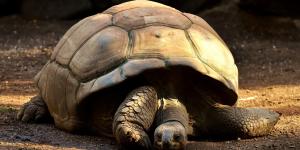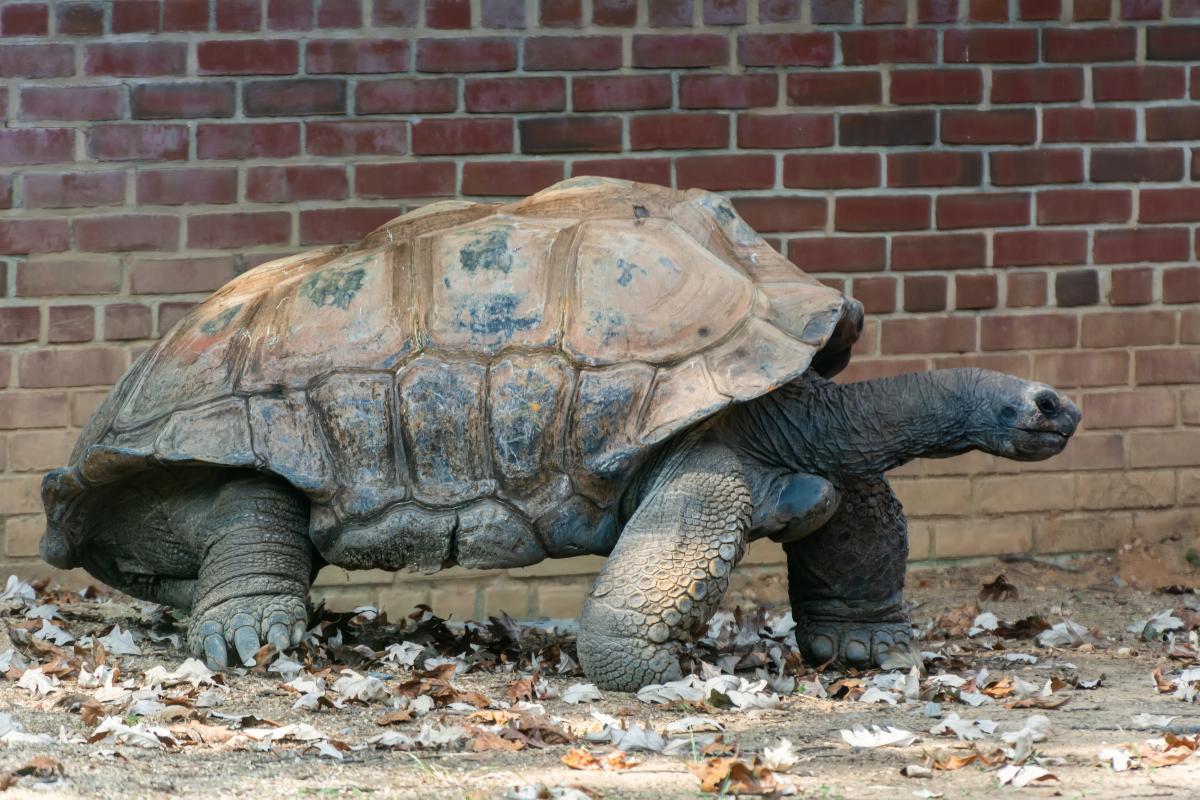Giant Tortoises and Turtles

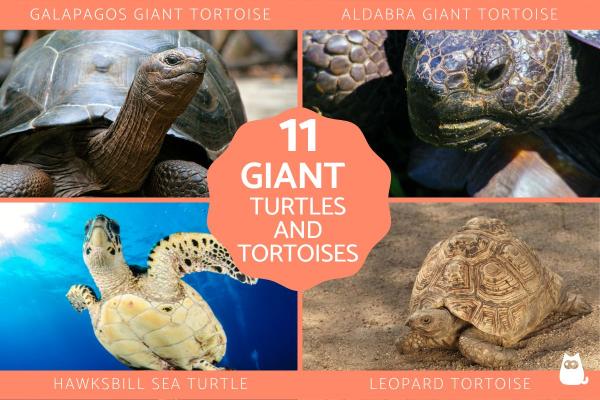
Found in various regions across the globe, giant tortoises and turtles have managed to thrive in diverse environments, both on land and in the vast oceans. Their resilient nature and ability to adapt to different conditions have allowed them to become living relics of the past, embodying the essence of survival through millennia. Their slow metabolic rates and extended lifespans allow them to continue growing over extended periods, leading to larger sizes.
The following AnimalWised article provided below lists the 11 largest turtles and tortoises in the world. It includes valuable information about their size, distinctive features, and current conservation status.
- Floreana Giant Tortoise (Chelonoidis niger)
- Leatherback sea turtle (Dermochelys coriacea)
- The Isabella giant tortoise (Chelonoidis vicina)
- Green sea turtle (Chelonia mydas)
- Loggerhead sea turtle (Caretta caretta)
- Leopard tortoise (Stigmochelys pardalis)
- Alligator Snapping Turtle (Macrochelys temminckii)
- African spurred tortoise (Centrochelys sulcate)
- Hawksbill sea turtle (Eretmochelys imbricata)
- Aldabra giant tortoise (Aldabrachelys gigantea)
- Other giant tortoises
Floreana Giant Tortoise (Chelonoidis niger)
The Floreana giant tortoise or the Pinta Island tortoise, is a captivating and historically significant species of giant tortoise native to the Galápagos Islands.
With a distinct saddle-shaped shell and a gentle, slow-moving nature, the Floreana giant tortoise is a living relic of the past, reflecting the unique evolutionary history of the Galápagos archipelago. Historically, these tortoises were distributed across several islands within the Galápagos, but due to human activities, such as hunting and habitat destruction, they faced significant population declines and even local extinctions.
Of particular note is the subspecies Chelonoidis niger abingdoni, also known as Lonesome George, who was the last known individual of his kind, found on Pinta Island. Tragically, Lonesome George passed away in 2012, marking the end of his subspecies. This event raised awareness about the urgent need for conservation efforts to protect the remaining giant tortoise populations on other islands.
The conservation status of the Floreana giant tortoise is classified as "Critically Endangered" by the International Union for Conservation of Nature (IUCN). Conservation initiatives have been put in place to preserve and restore the Floreana giant tortoise populations. These efforts include habitat protection, captive breeding programs, and the eradication of invasive species that pose a threat to the tortoises and their ecosystems.

Leatherback sea turtle (Dermochelys coriacea)
The leatherback turtle (Dermochelys coriacea) holds the distinction of being the largest living turtle species in the world. This magnificent creature is found throughout all the world's oceans, making it a truly global species. When it comes to nesting, the leatherback turtles prefer tropical beach sands as their nesting grounds.
The size of the leatherback turtle exceeds one meter (ca. 3.28 feet) in length and can measure up to 1.75 meters (ca. 5.74 feet). The weight range is estimated between 250 and 900 kilograms (ca. 551 to 1984 pounds).
Until 2015, the heaviest turtle officially reported weighed 650 kilograms (ca. 1433 pounds) and measured 2.13 meters (approximately 6.99 feet).
As for their conservation status, leatherback turtles are classified as "vulnerable" according to the International Union for Conservation of Nature (IUCN). This means that they face a significant risk of extinction in the wild due to various threats such as habitat destruction, accidental capture in fishing gear, pollution, and climate change. Sadly, their population trend is declining, making conservation efforts crucial to protect these magnificent creatures.

The Isabella giant tortoise (Chelonoidis vicina)
The Isabella giant tortoise (Chelonoidis vicina) is an impressive and endangered species native to Ecuador.
This tortoise easily is recognized for its dome-shaped shell, which is well-suited for the type of herbaceous vegetation it consumes. With a maximum length of 1.10 meters (ca. 3.61 feet) and a weight of around 100 kilograms (ca. 220 pounds), it is undoubtedly a substantial creature.
As for the conservation status of the Isabella giant tortoise (Chelonoidis vicina), it is classified as "Endangered" according to the International Union for Conservation of Nature (IUCN) Red List. Efforts are being made to conserve and protect the Isabella giant tortoise, both in its natural habitat and through captive breeding programs.
Feel free to explore our other article, where we discuss how turtles communicate.

Green sea turtle (Chelonia mydas)
The Green sea turtle (Chelonia mydas) is one of the largest sea turtle species, with adults reaching lengths of around 1.2 to 1.5 meters (ca. 3.9 to 4.9 feet) and weighing between 200 and 300 kilograms (ca. 441 to 661 pounds) on average. However, some individuals can grow even larger.
These sea turtles are widely distributed and can be found in tropical and subtropical waters around the world. They are known for their vibrant green-colored fat underneath their shells, which gives them their name. Green sea turtles are primarily herbivores, feeding on seagrasses and algae, and play a crucial role in maintaining the health of marine ecosystems.
Unfortunately, Green sea turtles face numerous threats to their survival. This species is classified as "Endangered" by the International Union for Conservation of Nature (IUCN) due to significant population declines over the years. Habitat destruction, pollution, climate change, and entanglement in fishing gear pose significant risks to their populations. Additionally, their eggs are often harvested for consumption, which further adds to their vulnerability.
Have you ever wondered if turtles have teeth? Find out all about it in our other article.
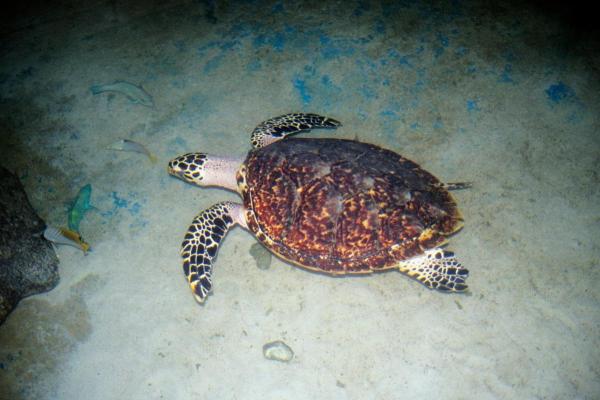
Loggerhead sea turtle (Caretta caretta)
The Loggerhead sea turtle (Caretta caretta) is an impressive marine reptile known for its large head and strong, sturdy shell. These turtles are opportunistic omnivores, with a diverse diet that includes crustaceans, mollusks, fish, and even jellyfish. Their powerful jaws enable them to crush hard-shelled prey with ease, making them essential in maintaining balanced marine ecosystems.
Loggerhead sea turtles are one of the largest of all sea turtle species, with adults typically measuring around 0.9 to 1.1 meters (ca. 2.95 to 3.61 feet) in length and weighing between 115 and 220 kilograms (ca. 253 to 485 pounds) on average. Female Loggerheads are generally larger than males.
Loggerhead sea turtles have a wide distribution and can be found in the Atlantic, Indian, and Pacific Oceans, as well as the Mediterranean Sea. They are highly migratory and often traverse vast distances between their feeding and nesting grounds.
This species is classified as "Vulnerable" by the International Union for Conservation of Nature (IUCN).
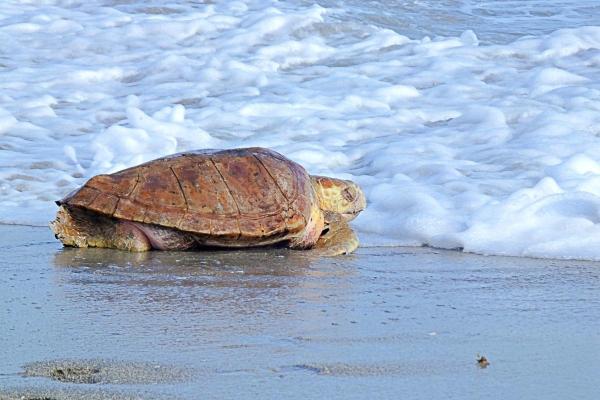
Leopard tortoise (Stigmochelys pardalis)
The Leopard tortoise (Stigmochelys pardalis) is a captivating and unique species of tortoise found primarily in the savannas and grasslands of eastern and Southern Africa.
The Leopard tortoise derives its name from the striking shell patterns that closely resemble a leopard's spots. These tortoises display a diverse array of shell patterns and colors, making each individual easily distinguishable.
Adding to their allure, Leopard tortoises are renowned for their impressive size, with adult specimens commonly measuring between 40 and 70 centimeters (ca.16 to 28 inches) in length, and occasionally even larger.
Leopard tortoises are known for their longevity, often living for several decades in the wild and even longer in captivity. They have a slow growth rate and can take many years to reach their full size, making their survival heavily dependent on conservation efforts.

Alligator Snapping Turtle (Macrochelys temminckii)
The alligator snapping turtle (Macrochelys temminckii) is a fascinating and unique species of freshwater turtle found primarily in the southeastern United States. This massive and impressive reptile is the largest freshwater turtle in North America and is known for its distinctive appearance and behavior.
The Alligator snapping turtle can reach impressive sizes, with some individuals weighing over 100 kilograms (220 pounds) and measuring more than 70 centimeters (28 inches) in length. Due to their large size and impressive appearance, they are often considered living fossils, having remained relatively unchanged for millions of years.
The Alligator snapping turtle's most striking feature is its large, powerful head, which resembles that of an alligator, hence its name. It has a hooked beak and a pink, worm-like appendage inside its mouth that acts as a lure to attract prey. The turtle's rough, spiked shell, often covered in algae, provides excellent camouflage in its aquatic environment.
Unlike some other freshwater turtles, the Alligator snapping turtle is almost entirely aquatic and is most commonly found in slow-moving rivers, swamps, and lakes. It prefers deep water with plenty of vegetation and submerged logs to hide and ambush prey.
However, like many other turtle species, the Alligator snapping turtle faces various conservation challenges. Habitat loss, water pollution, and overexploitation due to illegal pet trade have contributed to declines in their populations. As a result, they are listed as a "Threatened" species by the International Union for Conservation of Nature (IUCN).
Discover a wide array of river turtle species by exploring our other article.
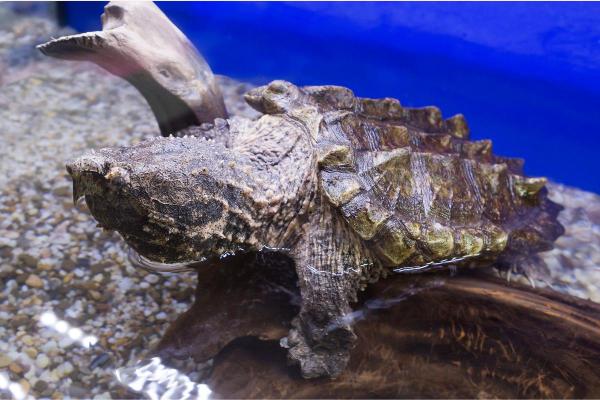
African spurred tortoise (Centrochelys sulcate)
The African spurred tortoise (Centrochelys sulcate) also known as the sulcate tortoise, is a magnificent and robust species of tortoise native to the southern edge of the Sahara Desert in North Africa.
The sulcata tortoise is characterized by its massive, dome-shaped shell covered in prominent, raised scutes. These scutes, or plates, form deep furrows or "sulci" on the shell's surface, giving rise to its common name, "sulcata."
In their natural habitat, these tortoises inhabit arid and semi-arid regions with sandy soils, where they have adapted to endure high temperatures and scarce water resources. Their powerful limbs and sturdy claws allow them to dig burrows to seek refuge from extreme heat and to find cooler spots in the ground.
Sulcata tortoises have a slow growth rate and can reach impressive sizes over time. Adult specimens typically measure around 60 to 80 centimeters (ca. 24 to 31 inches) in length and can weigh between 45 to 91 kilograms (ca. 99 to 200 pounds) or even more in some cases.
Due to their remarkable size and endearing personalities, sulcata tortoises have become popular in the pet trade. However, this popularity has also led to issues related to unsustainable wild harvesting and improper captive care. In fact, this species is currently ranked as an endangered by the International Union for Conservation of Nature (IUCN).
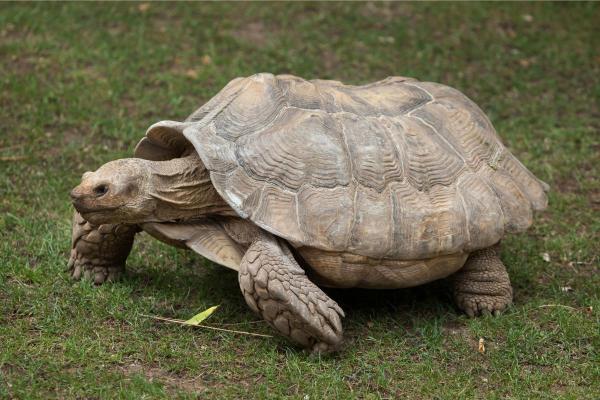
Hawksbill sea turtle (Eretmochelys imbricata)
The Hawksbill sea turtle (Eretmochelys imbricata), is a species of sea turtle that inhabits tropical and subtropical waters around the world.
This species has a carapace length of around 70 to 90 centimeters (ca. 27.5 to 35.4 inches) when fully grown. Some individuals may reach even larger sizes, with carapace lengths exceeding 1 meter (ca. 39.4 inches) in rare cases.
The Hawksbill sea turtle is renowned for its beautiful shell, which is characterized by overlapping, pointed scales, giving it a distinctive and intricate appearance. Their shells are highly valued for their "tortoiseshell" pattern,
Despite their significance in marine ecosystems, Hawksbill sea turtles face an array of threats that have pushed them to the brink of extinction. Habitat loss, pollution, climate change, entanglement in fishing gear, and poaching for their shells and meat have all contributed to the drastic decline in their populations.
Due to these grave threats, the Hawksbill sea turtle is classified as "Critically Endangered" by the International Union for Conservation of Nature (IUCN). This designation indicates that urgent and immediate conservation measures are required to prevent their disappearance from the wild.
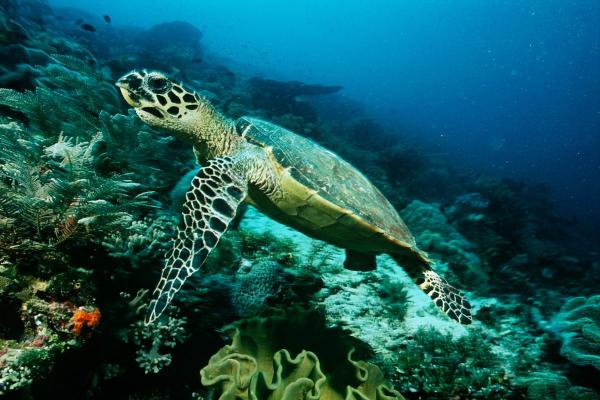
Aldabra giant tortoise (Aldabrachelys gigantea)
The Aldabra giant tortoise (Aldabrachelys gigantea), is a native species to the Aldabra Atoll in the Seychelles. As one of the largest tortoise species in the world, the Aldabra giant tortoise is celebrated for its immense size, longevity, and unique history.
These tortoises are famous for their enormous size, with adult specimens often reaching lengths of 90 to 120 centimeters (ca. 35 to 47 inches) and weighing between 200 and 250 kilograms (ca. 441 to 551 pounds) on average. Some individuals can grow even larger, making them true giants among tortoises.
The Aldabra giant tortoise is best known for its characteristic saddle-shaped shell with raised scutes. The shell's shape and design have earned it the nickname "saddleback tortoise." Additionally, their long necks and limbs enable them to reach vegetation at various heights, making them well-adapted to their native environment.
These tortoises are herbivores and primarily feed on grasses, leaves, and other vegetation. Due to the abundance of food resources on their remote island home, Aldabra giant tortoises can live for more than a century, with some individuals estimated to be over 150 years old.
The Aldabra Atoll, where these tortoises are found, is a UNESCO World Heritage Site and provides a protected habitat for the species. This conservation status has significantly contributed to the Aldabra giant tortoise's survival and population recovery.
As living relics of the ancient world, Aldabra giant tortoises are a testament to the importance of conservation efforts in preserving unique and vulnerable species for future generations to admire and cherish.

Other giant tortoises
In addition to the previously mentioned species, we would like to introduce you to other fascinating giant tortoises:
- Giant tortoise (Chelonoidis abingdonii)
- Wolf volcano giant tortoise (Chelonoidis becki)
- Fernandina giant tortoise (Chelonoidis phantasticus)
- Saint Christopher Giant Tortoise (Chelonoidis chathamensis)
- Darwin's volcano giant tortoise (Chelonoidis microphyes)
These remarkable creatures are all part of the Chelonoidis genus, and each boasts unique characteristics and habitats.
By sharing this information, we hope to spark curiosity and appreciation for these magnificent creatures and raise awareness about the importance of their conservation and protection for generations to come.
Make sure not to miss our other article, where we provide a comprehensive description of the various aspects of turtle anatomy.
If you want to read similar articles to Giant Tortoises and Turtles, we recommend you visit our Facts about the animal kingdom category.
- Animal Diversity Web. (2020). Available at: https://animaldiversity.org/
- IUCN (2023). The IUCN Red List of Threatened Species. Version 2022-2. Available at: https://www.iucnredlist.org
- McClain, CR, Balk, MA, Benfield, MC, Branch, TA, Chen, C., Cosgrove, J., ... & Thaler, AD (2015). Sizing ocean giants: patterns of intraspecific size variation in marine megafauna. PeerJ , 3 , e715.

